Milestones
Milestones
Victoria School grew, just like her students. She grew from Singapore’s colonial past to the present in 2016. Through the unwavering spirit of our pioneering staff and students, the school grew from strength to strength, and built up the rich heritage and traditions that present Victorians enjoy. Today, Victoria School is one the top schools in Singapore, a school known for the emphasis on character and leadership excellence.
-
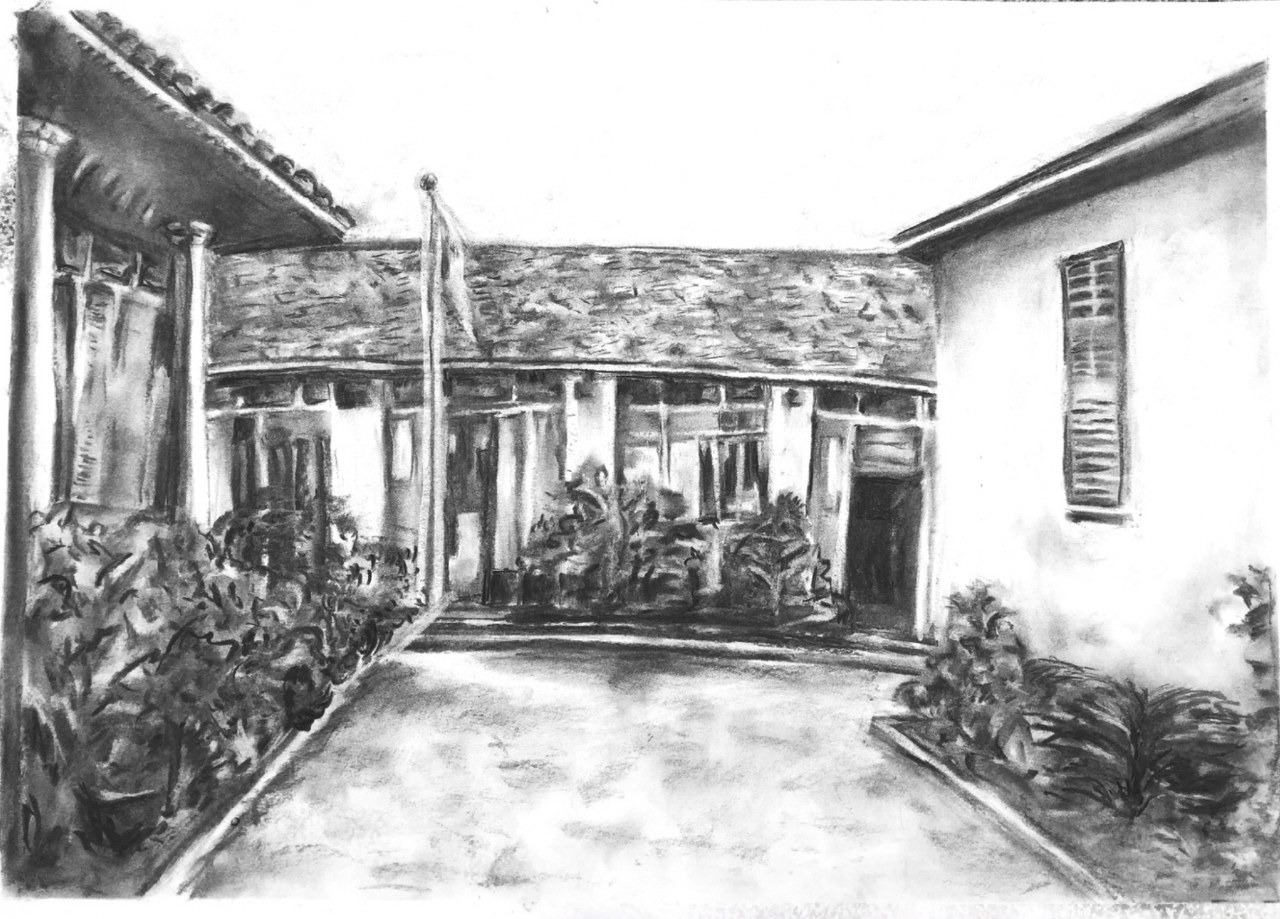
Victoria School is the second oldest government secondary school in Singapore. It originated as an English class established in 1876 in Kampong Glam Malay Branch School.
Early colonial era education was more of a private, rather than government, concern. Charitable organisations, public-minded individuals and missionary bodies were among the early pioneers of formal Malay and English education. By the 1870s, the Straits Settlements Government decided to improve English language standards in schools.[1] The chief function of a “Branch English School” was to teach English language and the vernacular language (Malay for the case of Kampong Glam Malay School). This was part of the effort of the Straits Settlements to relieve the pressure of overcrowding at major schools like Raffles Institution in Singapore, and the Free Schools in Penang and Malacca. The branch schools catered to boys of all social classes who stayed further away from the larger English schools. The Kampong Glam Malay Branch School aimed to help Malays benefit from English education.[2]
[1] Ernest Cheong, “Victoria School in Singapore 1976-1987” (BA Honours Thesis, National University of Singapore 1987/88), 5.
[2] Cheong, “Victoria School.”, 8.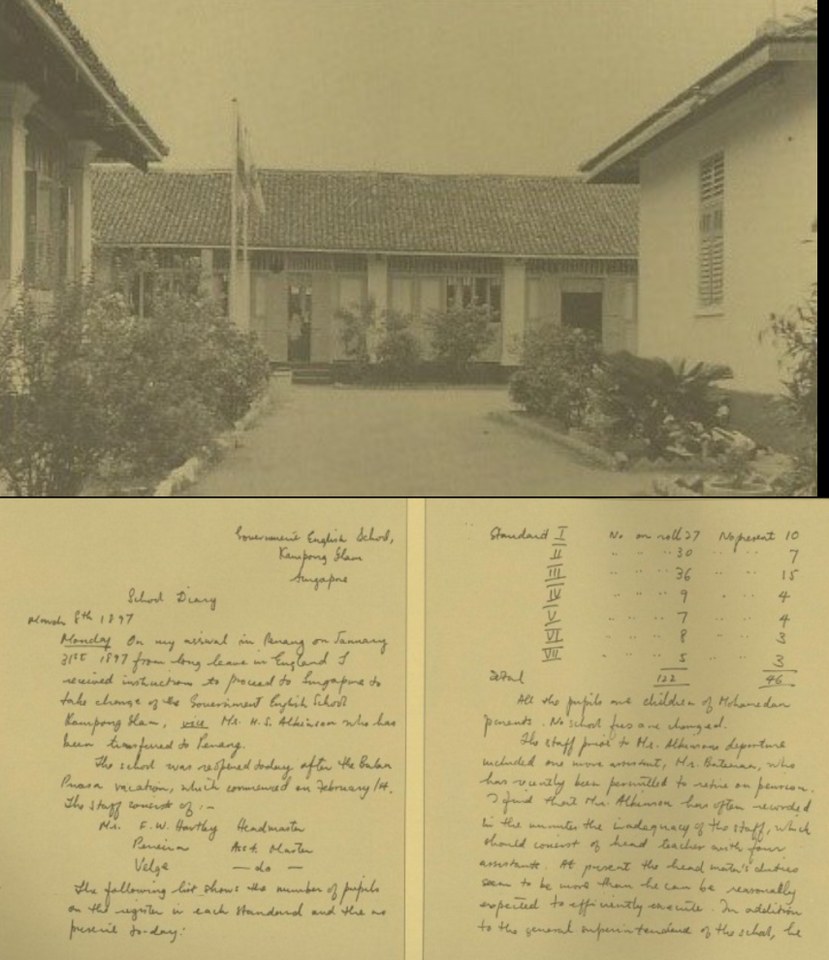
Our first headmaster was Mr Y. A. Yzelman, who organised and taught English lessons to 12 Malay boys. -
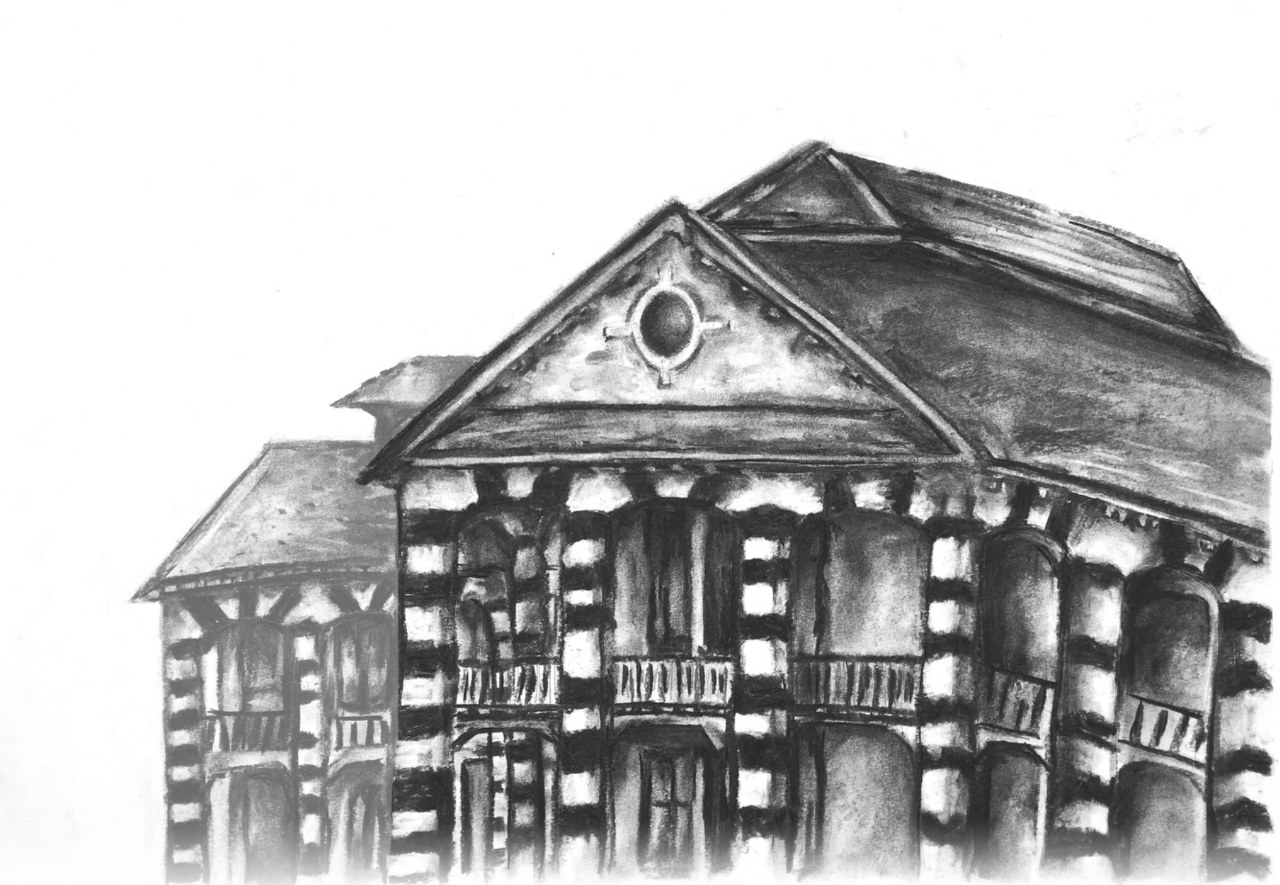
In 1897, Kampong Glam Malay Branch School merged with Kampong Glam Malay School. The school moved to Syed Alwi Road, which was close to Victoria Bridge. Hence, the school’s name was changed to Victoria Bridge School.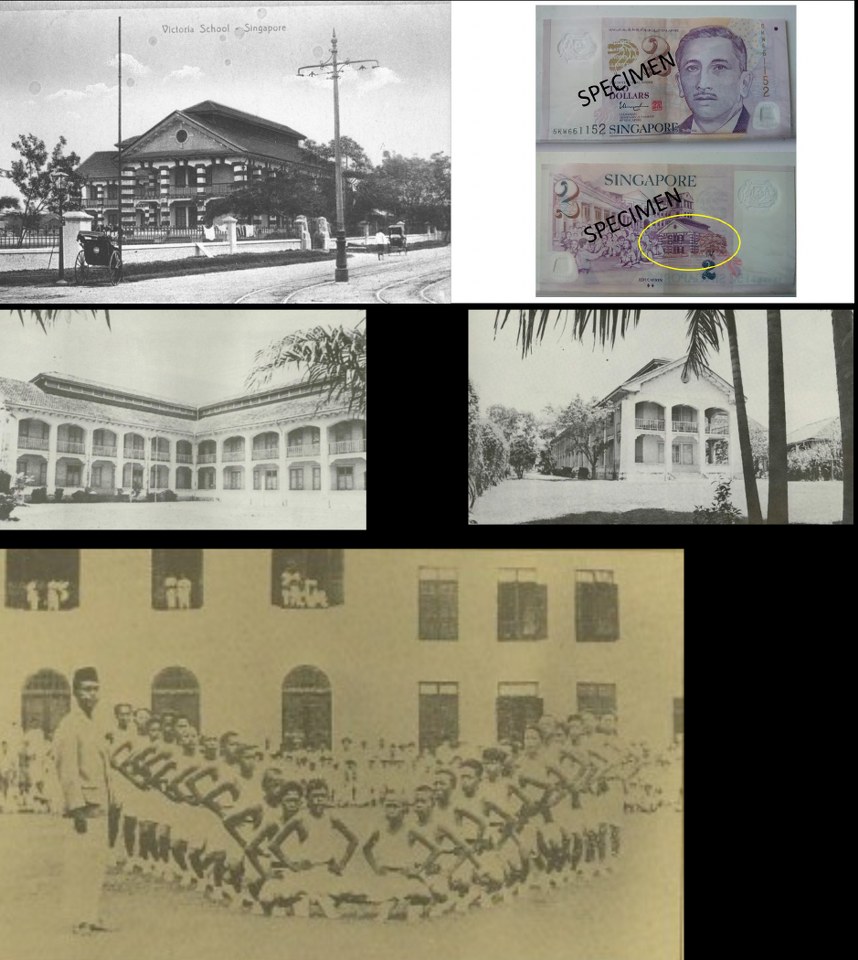
Victoria Bridge School was a preparatory school to aided English secondary schools and Raffles Institution. Raffles Institution was the only government secondary school back then. The conversion of Victoria Bridge School into a secondary school was considered, but it was decided that Victoria Bridge School was more effective as a feeder school. In 1909, Victoria Bridge School started classes at Standard Five, as Raffles Institution faced capacity challenges. Until 1930, the school only had primary classes from Primary One to Standard Five. Victoria Bridge School’s enrolment gradually increased, due to growing demand for English education and education policies relating to Raffles Institution. By 1925, the student enrolment reached 705, beyond the government’s recommended capacity of 560. There were official school holidays such as the King’s birthday and Empire Day. Separate holidays were given to different ethnic groups for their respective festivals.[3]
In 1930, Victoria Afternoon School began, catering to students who could not progress to Raffles Institution after passing Standard Five and to those who left school to provide spaces for students of normal ability and age. Victoria Afternoon School was not part of Victoria Bridge School. However, as Victoria Bridge School’s headmaster was overall-in-charge, it was still part of Victoria School’s history. The afternoon classes ended in 1952. In 1931, during the period of Rev A.J Amery’s headship, Victoria Bridge School became the second government secondary school, as Raffles Institution faced continued capacity challenges.[4]
Problems existed during the earlier period of Victoria Bridge School’s history. Just like the first campus, dust clouds blew into the classrooms occasionally. The school was also flooded on rainy days. There was overbearing stench from the nearby drain and mud and continuous street noises. During that era, students and parents were indifferent towards education. Attendance was poor. When employment opportunities arose, students left. Parents often appeared unconvinced of the benefits of letting their child complete an English education or were too poor to sustain their boys’ education beyond 13 years old. School staff was insufficient. In 1902, five teachers taught eight different standards. Some teachers faced absenteeism or misconduct problems. Salaries were meagre. Certified government teachers frequently left for better salaries.[5]
To improve the quality of education, headmasters such as Mr P. A. Yearwood, Mr H. Laugher and Mr M. B. Brockwell, enforced stronger discipline and attendance. The earliest records of the uniformity in school dress were in 1929. These strengthened the school’s formal status, improved student attendance and resulted in positive student behaviour.[6] A prominent businessman then, Syed Ahmed bin Mohamed Alsagoff helped the school when he donated $1,000 to create a school library which was opened on 27 December 1929.[7]
The principals further strengthened student character and morale through students’ involvement in games. New roles were created, such as team captains and games’ committees. These reinforced student identity and built the school’s image as a community.[8]When Mr. R.E. Smith became the headmaster (1911-1912), the first scout group, called the Sixth Troop, was formed under Mr. S. R. Williams, a Mathematics teacher. The first annual Sports Meet was held in 1915. In 1916, the first annual Speech Day was held and the first annual prize for academic achievements commenced. In 1929, the ‘House System’ was introduced to build the Victorian spirit.[9] To maintain discipline and develop leadership, the House Prefects were formed in 1930.[10]
[3] Cheong, “Victoria School.”, 20-24.
[4] Cheong, “Victoria School.”, 25.
[5] Cheong, “Victoria School.”, 14-18.
[6] Cheong, “Victoria School.”, 18-19.
[7] The Straits Times, 11 December 1929, 12.
[8] Cheong, “Victoria School.”, 27.
[9] Cheong, “Victoria School.”, 19-20.
[10] “A Brief History of Victoria School,” The Victorian, 1986, 2. -
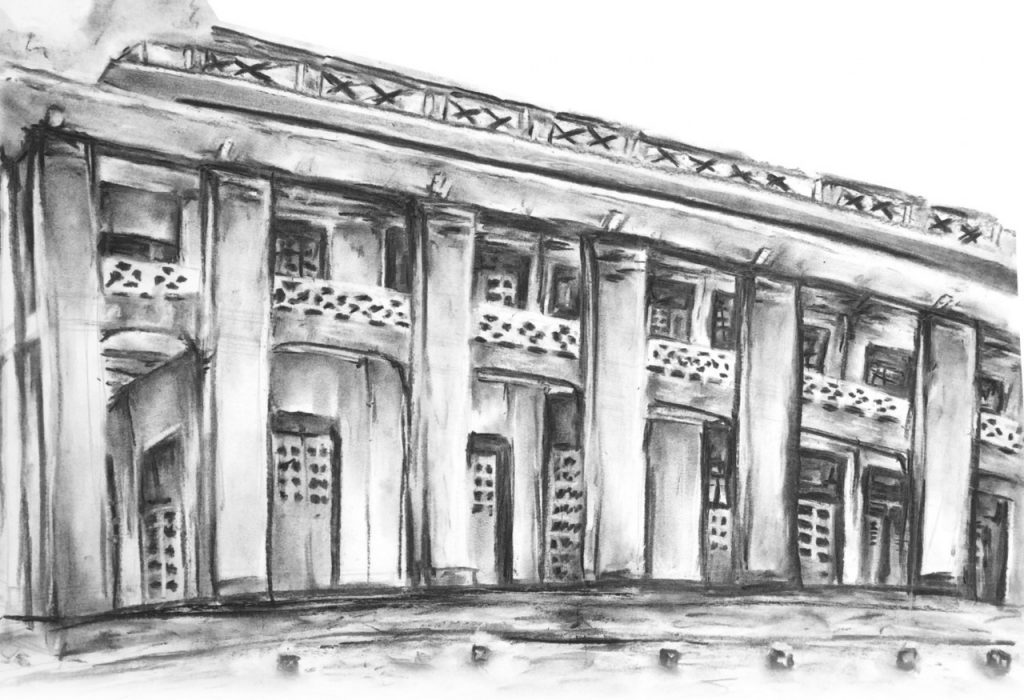
In 1933, the school moved to Tyrwhitt Road and became known as Victoria School. The school had more spacious classrooms with high ceilings and Roman-like columns. The surroundings were also cleaner.[11] The school had its first candidates for the Junior Cambridge Examination in 1933, and for the Senior Cambridge Examination in 1934.[12] In 1935, Victoria School phased out her primary classes to become a purely secondary school for her district.[13]
Under Mr E. H. Wilson in 1938, the prefect badge was introduced. The School motto “Nil Sine Labore” (Latin), meaning “Nothing without Labour” also came into existence. At the Amateur Athletic Association finals in 1940, Ali bin Ahmad won the 100 yards in 10 seconds and his name appeared in the Hall of Fame.[14] In the years 1939 and 1940, the school won the Sir Arthur Young Cup in the Inter-School relay event. In 1941, the Old Victorians’ Association was established.[15]
In June 1940, war drew near. Victoria School conducted blackout preparations and air raid drills were held.[16] In November 1941, then-headmaster, Mr E. H. Wilson, reported that Victoria School was contributing by serving as an Aid Raid Precaution post and training centre and as a depot and aid post for the Medical Auxiliary Services[17].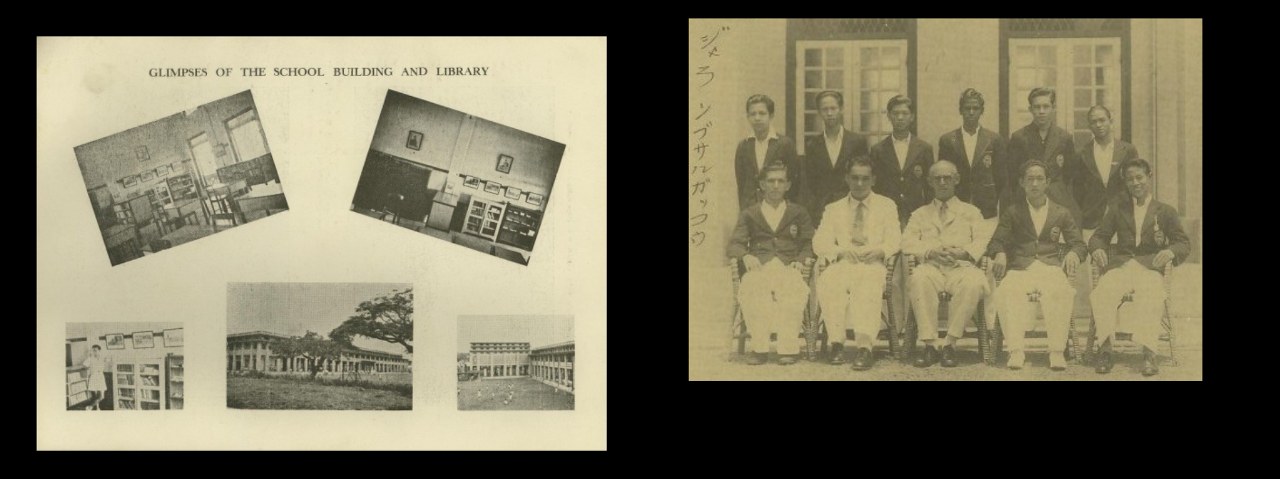
During the Japanese Occupation in 1942, Japanese troops occupied the school and did screening of the people. Some staff, including some British expatriates, were taken away and never seen again. Schools were renamed based on the streets where they were located, and were only allowed to reopen in mid-1942. Victoria School, was thus renamed as “Jalan Besar Boys’ School”, and became one of the many Japanese public schools. Mr S. R. Williams was headmaster during this challenging period. The curriculum consisted of Japanese reading, Japanese songs, arithmetic, nature study, agriculture and writing. The teaching of English continued despite it being frowned upon. School children attended a daily flag raising ceremony to the Japanese national anthem, the Kimigayo. Bows followed, first towards Tokyo and then towards the Principal. Physical drill was also carried out together with music broadcasted by Radio Taisho.[18] Food was scarce. All available school land was used for growing vegetables and tapioca. Teachers and students experienced hardship and improvised with what they had.[19]
When war ended in 1945, Mr S. R. Williams gathered 16 boys and started classes again. Victoria School became one of the earliest schools to reopen, occupying the Kampong Glam Malay School premises from 1 Oct 1945, as the British Military Administration used the Tyrwhitt Road building as a temporary hospital. She only returned to the Tyrwhitt Road building in May 1946.
After the war, headmasters Reverend Colin King and Mr P. F. Howitt helmed Victoria School for brief periods and also oversaw the immediate post-war rehabilitation programme to restore the buildings and equipment. During this period, the Colonial Government launched a Ten Year Education Programme. The Old Victorians’ Association, with their expertise and resources, also contributed towards the school’s recovery.
[11] Santokh Singh Grewal, “History of VS”, The Victorian, 1990, 24.
[12] S.R. Williams, “History of Victoria School,” Victoria School Magazine, September 1948, 3.
[13] Cheong, “Victoria School.”, 20.
[14] “A Brief History of Victoria School,” The Victorian, 1986, 2.
[15] Santokh Singh Grewal, “History of VS”, The Victorian, 1990, 25.
[16] Cheong, “Victoria School.”, 35.
[17] The Straits Times, 26 November 1941.
[18] Cheong, “Victoria School.”, 37-38.
[19] “A Brief History of Victoria School,” The Victorian, 1986, 2.
After Mr Howitt, Mr R. F. Bomford became the headmaster in 1948. He planned the construction of the Science Block, which opened in 1950. The Science Block housed the General Science and Biology Laboratories, and were reputedly Singapore’s best school laboratories. Students from Raffles Girls’ School and St. Andrew’s School also came to attend the science classes.[20]Under Mr Bomford, Victoria School was the colony’s selected school to pioneer audio-visual teaching.[21] Our annual Victoria School magazine also began its publication in 1948.
[20] “A Brief History of Victoria School,” The Victorian, 1976, 17.
[21] Cheong, “Victoria School.”, 45.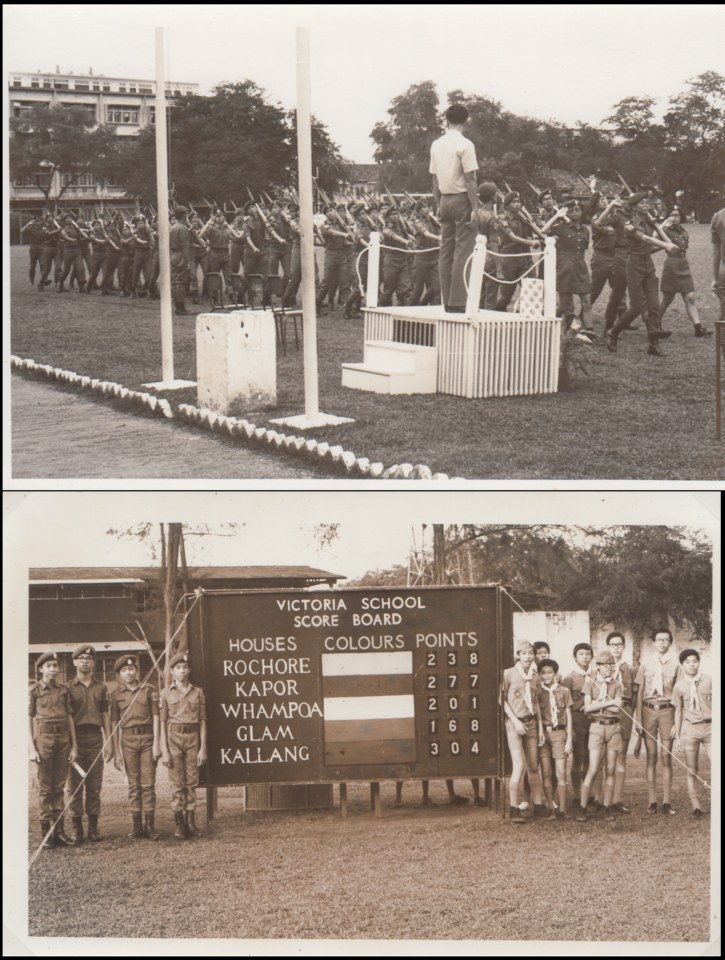
Due to the Japanese invasion and occupation, those who sat for the Senior Cambridge Examination in December 1941 waited till 1946 to know their results. Our school did well, with 84 percent passes and 16 percent obtaining Grades 1 to 3.[22] In 1951, the first Pre-University (then called the Post School Certificate) classes started and admitted girls.[23] In 1955, 99.5% passed the Cambridge Overseas School Certificate Examinations, making it Singapore’s best boys’ school. In 1957, the school had the best results in the University Entrance Examinations. In addition, two of the three Queen’s Scholarships were awarded to Victorians Teh Ee Kheng (for Arts) and Yap Choon Teck (for Science).[24]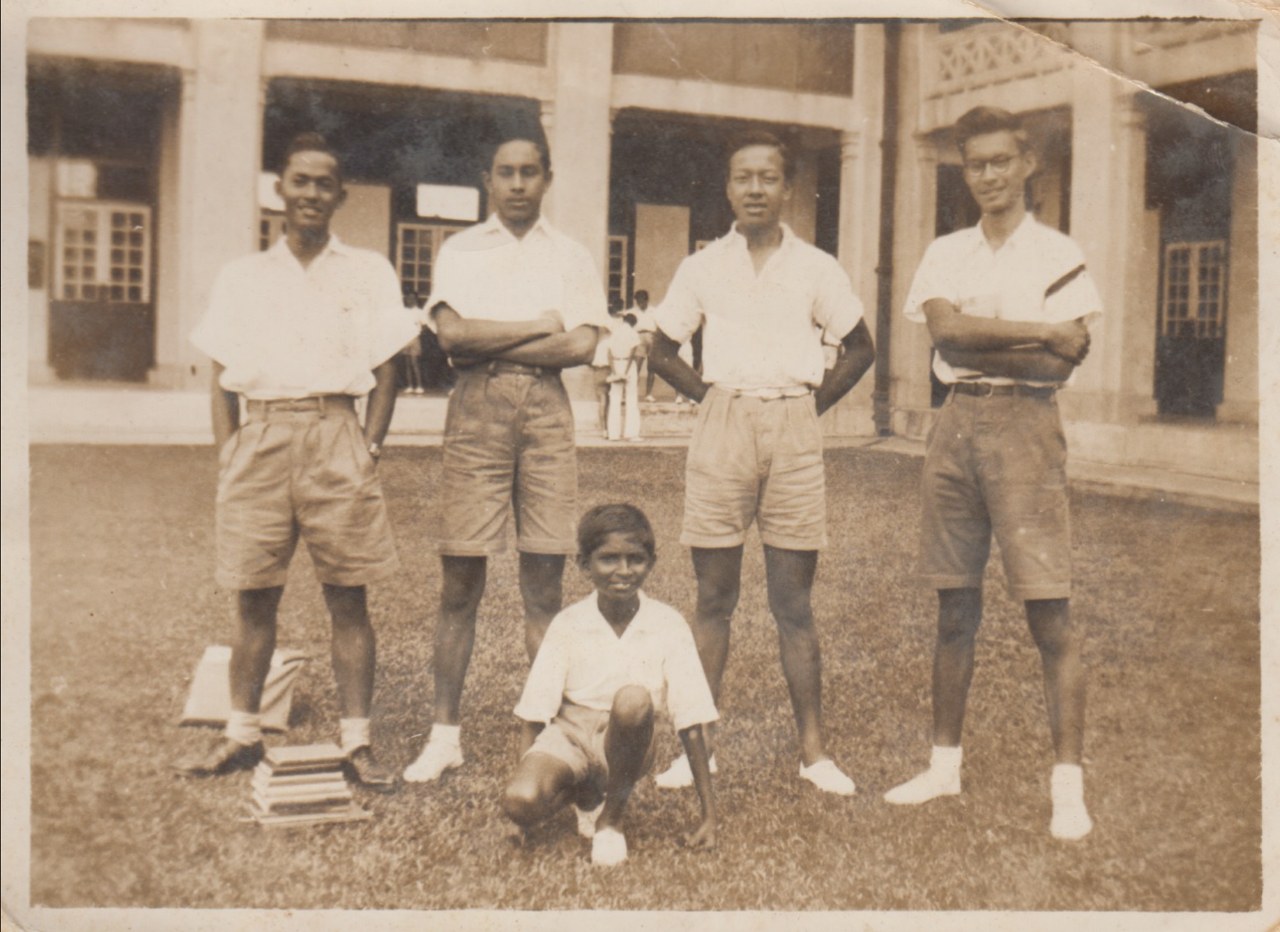
Our school song was composed and set to the music in the early 1950s. Mr Bomford contributed his energy and talent to make Victoria a top school. Upon his death in 1953, grateful Victorians organised the Bomford Memorial Fund in 1954 (now administered by the Old Victorians’ Association) to award outstanding pupils.[25]
[22] “History of Victoria School,” The Victorian, 1969, 20.
[23] Cheong, “Victoria School.”, 41.
[24] “Milestones of Victoria School”, Victorian, 1997, 192.
[25] “A Brief History of Victoria School”, The Victorian, 1985, 3.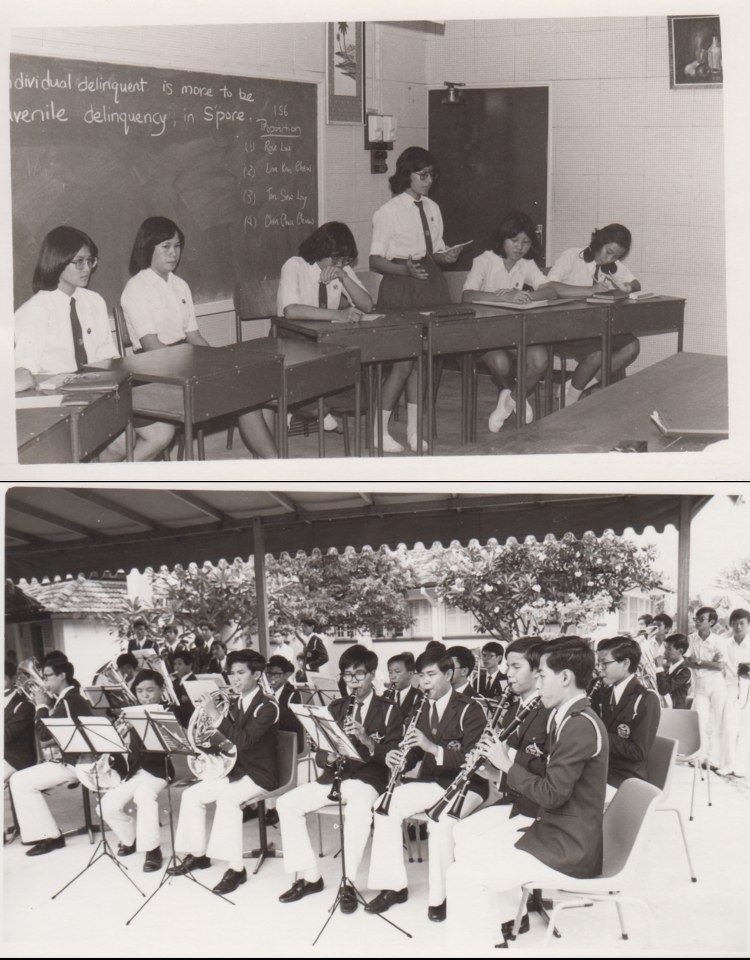
In 1954, Mr. M Campbell was appointed Principal of the school. During his stewardship, our school attained high academic honours. Mr. Campbell left in 1958 and within a period of seven years, we had eight principals.
From April 1966 to January 1971, Mr. A Kannayson became the Principal. This was a period of change and growth for the school. The school’s enrolment in 1967 was 1672 students for two sessions, although her capacity was for 400.[26]
In 1966, a one-year $660,000 upgrade began. The extension consisted of four new laboratories, a new hall, canteen, staffroom, 14 classrooms, eight toilets and a basketball court. In 1969, the old building was modified for a bigger library and an Educational Television hall. The school could then accommodate 11 Pre-university and 11 Secondary Four classes in the morning; and 8 Secondary Three, 10 Secondary Two, and 7 Secondary One classes in the afternoon.[27] Victoria School’s GCE ‘O’ Level passes rose from 50.1% in 1971 to 71.55% in 1975.[28] During his time, the school also made great strides in extra-curricular activities. For example, in the Track and Field competition in 1981, she won three age divisions in the National Athletics Meet, a first in the history of schools’ sports. There was a considerable improvement in student and staff morale.
[26] Cheong, “Victoria School.”, 63.
[27] Cheong, “Victoria School.”, 63-64.
[28] Cheong, “Victoria School.”, 63-65.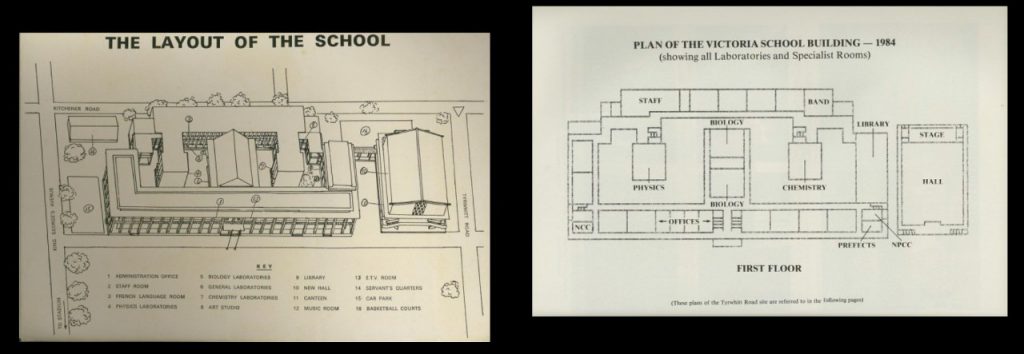
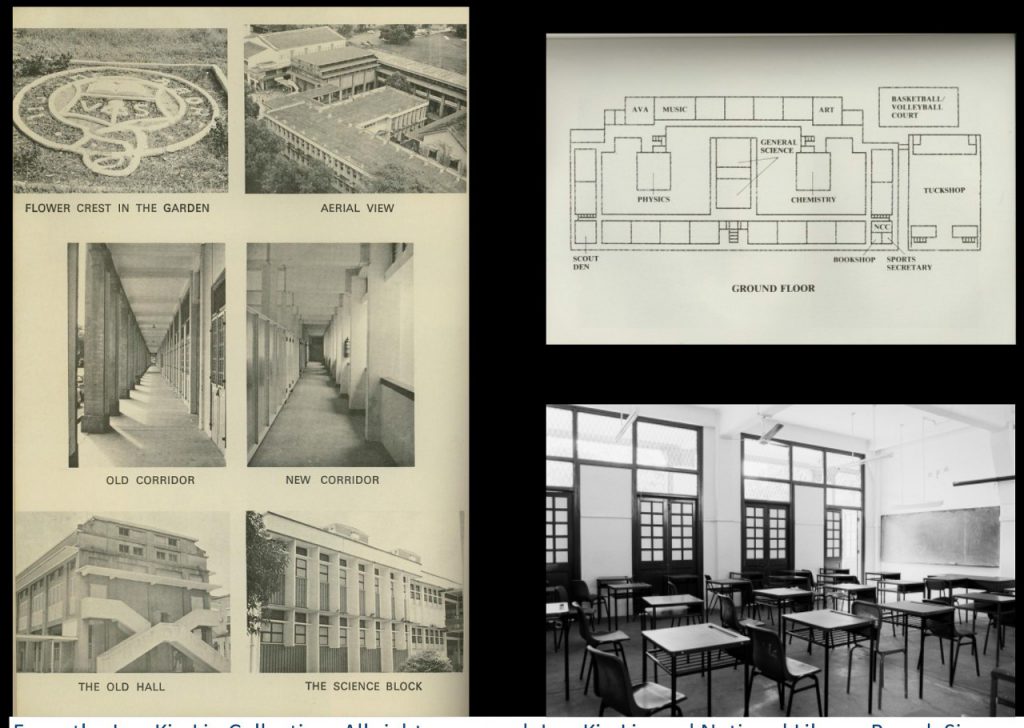 From the Lee Kip Lin Collection. All rights reserved. Lee Kip Lin and National Library Board, Singapore 2016
From the Lee Kip Lin Collection. All rights reserved. Lee Kip Lin and National Library Board, Singapore 2016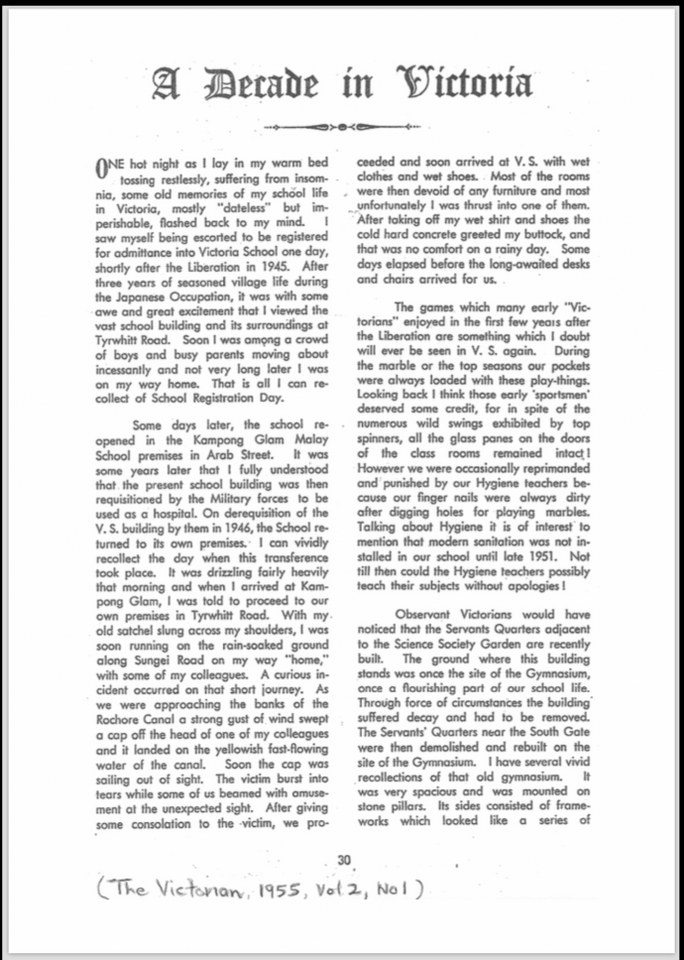
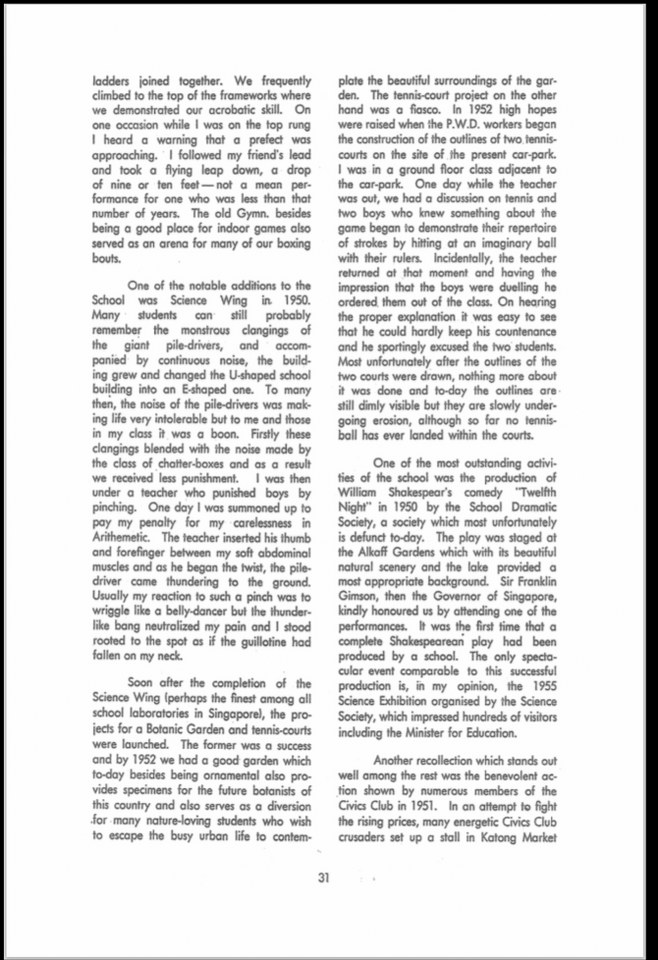
 Dr Sim Keng Yeow is a retired Professor and former Head of the Chemistry Department in the National University of Singapore from 1988 to 1996. This essay was first published in the 1955 Victoriana.
Dr Sim Keng Yeow is a retired Professor and former Head of the Chemistry Department in the National University of Singapore from 1988 to 1996. This essay was first published in the 1955 Victoriana.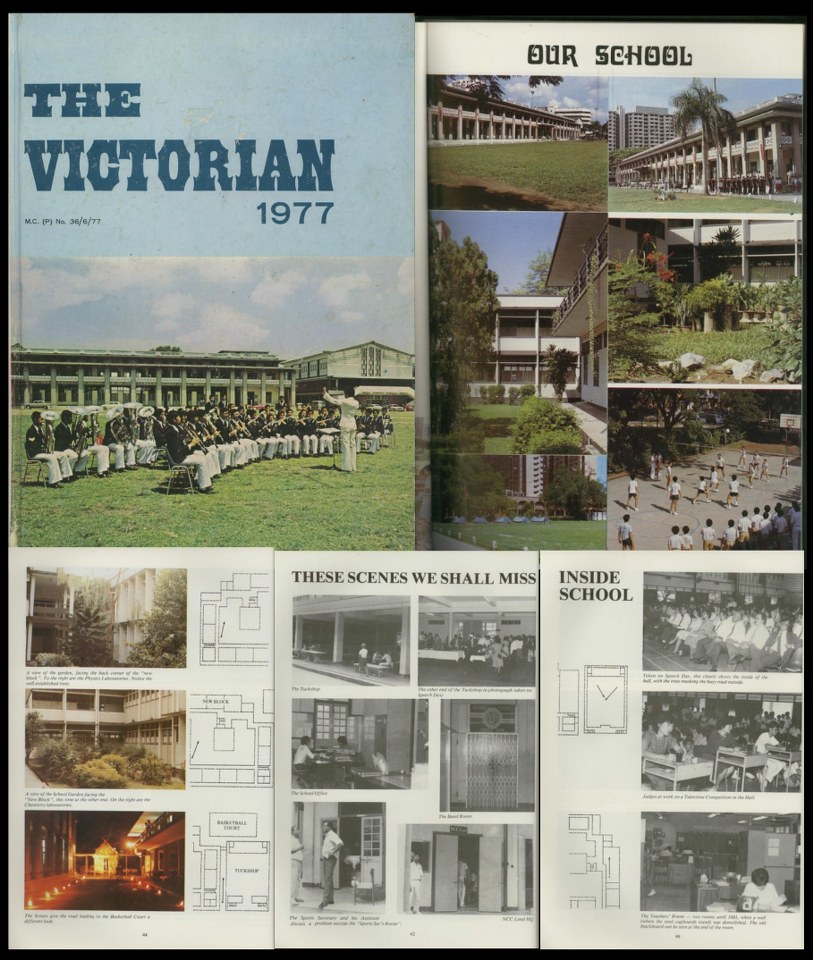
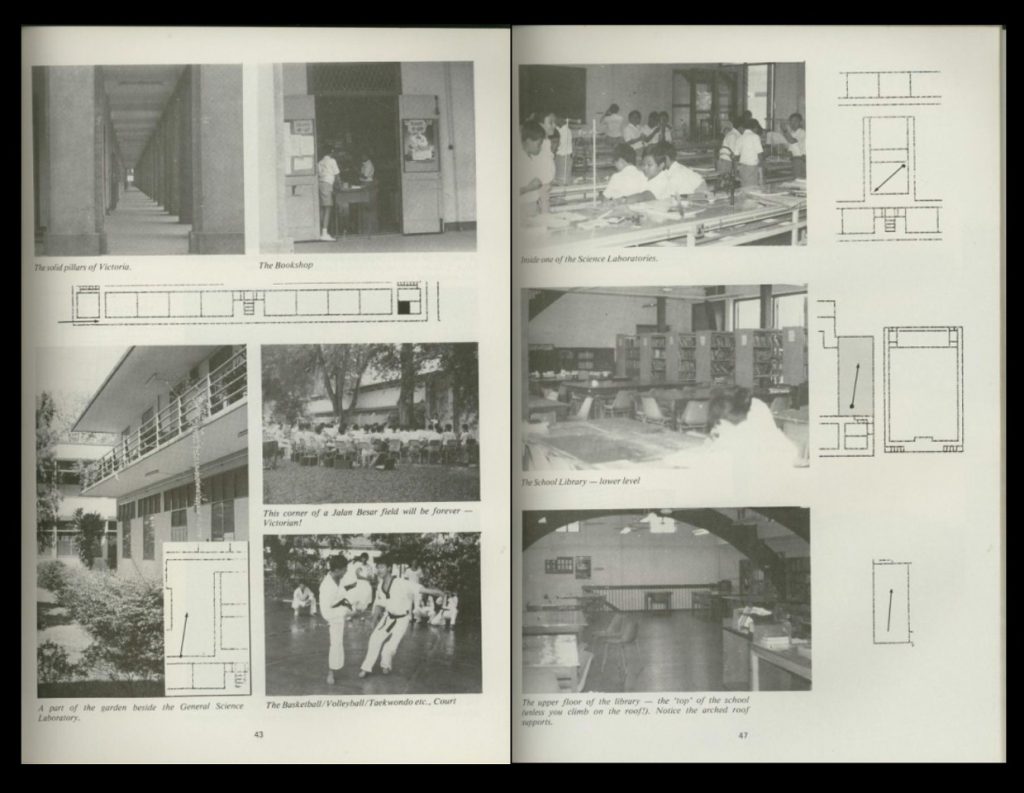 In 1969, the Junior College system was introduced. In 1979, Victoria School became a pre-university centre, offering three-year pre-university courses. The brightest Victorians went to junior colleges to study, instead of continuing with the pre-university courses. To cope with the competition provided by the junior colleges, and in pursuit of providing quality education, the Old Victorians’ Association and the Victoria Executive Committee worked together to establish Victoria Junior College, where Victorians could further their junior college education.[29]
In 1969, the Junior College system was introduced. In 1979, Victoria School became a pre-university centre, offering three-year pre-university courses. The brightest Victorians went to junior colleges to study, instead of continuing with the pre-university courses. To cope with the competition provided by the junior colleges, and in pursuit of providing quality education, the Old Victorians’ Association and the Victoria Executive Committee worked together to establish Victoria Junior College, where Victorians could further their junior college education.[29]
[29] “Speech by Dr. Ong Chit Chung, Chairman, Victoria Executive & Advisory Committees at Victoria School’s 127th Speech Day, 26 July 2003,” The Victorian, 2003, 70-71. -
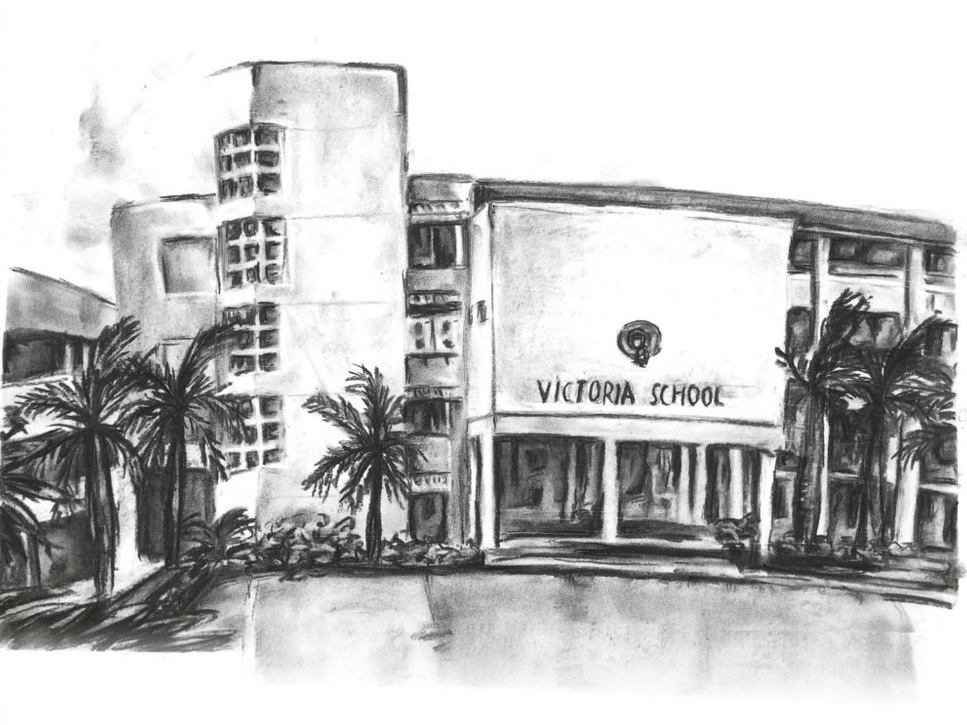
In 1984, Victoria School moved to Geylang Bahru while Victoria Junior College was established in Marine Parade, offering the GCE ‘A’ level programme. In 1985, Victoria School conducted her last pre-university classes and from 1986 onwards, Victoria School catered to only secondary students.[30] In 1985, Victoria School started the Art Elective Programme, and was provided with Arts, Print-Making, Pottery and 3D Activity Studios. The school’s first computer laboratory was also set up in 1986.
[30] “A Brief History of Victoria School”, The Victorian, 1986, 3.
Ministry of Information and the Arts Collection, courtesy of National Archives of Singapore
In 1986, Victoria School achieved 97.5% five GCE ‘O’ Level passes. When the national school ranking system began in 1992, Victoria School was amongst the top ten schools in 1993, 1995, 1996 and 1999.
In 1989, Victoria School was among the few selected schools to receive ASEAN scholars. Capacity-wise, the school building was extended in 1991 to prepare for single-session schooling, which commenced in 1992. This included a four-storey block with 17 classrooms and a void deck.
Ministry of Information and the Arts Collection, courtesy of National Archives of Singapore
During the late 1980s and early 1990s, the new challenge of independent schools arose. Independent schools are granted greater flexibility than other schools to design their own school curriculum and programmes, choose their own students and set their own school fees. Their school fees are therefore usually higher than that of government-run schools. The VEC deliberated, and decided to remain as a government school, true to the original mission of providing good education to a wide spectrum of students.
On 11 July 1987, the first Victoria Challenge was inaugurated by Mr Nicholas Tang, then Principal of Victoria School. This quadrennial event allows classes to identify tasks that contribute tangibly to the school and community. This contribution can be either aesthetic or ‘atmospheric’. The Victoria Challenge is for classes to plan tasks and pledge completion within the allocated twenty-four hours. As part of the tradition, there is a school-wide challenge that the whole school participates in to benefit the community. Through Victorian Challenge, Mr Tang wanted Victorians to know that they can make tangible contributions to the family, school, community, work and nation. He hoped the event would build student pride, identity, morale and confidence. Over time, the Victoria Challenge became an event that all Victorians look forward to in their Victorian years. Every Victorian will only go through it once in his four years of secondary school education.
To help every Victorian achieve an all-round performance and to provide motivation for better results Victoria School pioneered the Victorian Profile certificate in 1991 under Mr Tan Tiek Kwee’s leadership. The Victorian Profile measured the all-round performance of Victorians and the school.
Recognized for her provision of high quality education in Singapore, Victoria School became one of the six pioneer Autonomous Schools in 1994. The announcement was made at our school’s Speech Day in 1993, when then-Minister for Education, Mr Lee Yock Suan, was Guest-of-Honour.[31] Autonomous Schools aim to provide better quality education affordably. In 2001, Victoria School became the seventh Secondary Gifted Education Programme centre and hosted the Gifted Education Programme from 2001-2005.
Approaching the new millennium, the Victoria Executive Committee worked towards the revitalization of Victoria School. The Victoria Executive Committee decided that Victoria School would attract even better students by moving to the east, closer to Victoria Junior College in Marine Parade. The Siglap Link site, where the Marine Parade Bus Terminal stood at, was favoured. However, the government planned to zone this prime land for condominium development. Through the efforts of the Victoria Executive Committee, approval was granted by the Ministry of Education and the Ministry of National Development for part of the land to be allocated for the new Victoria School campus at Siglap. To enhance the school’s competitiveness, a hostel was integrated as part of the school design
[31] The Victorian, 1993, 51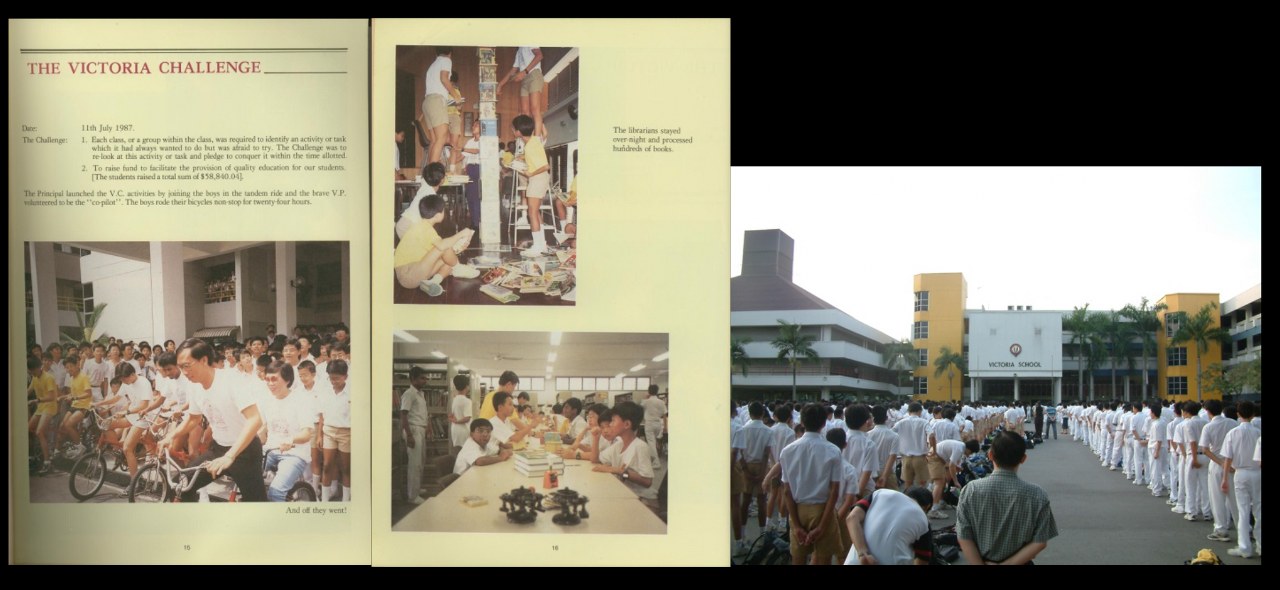
Approaching the new millennium, the Victoria Executive Committee worked towards the revitalization of Victoria School. The Victoria Executive Committee decided that Victoria School would attract even better students by moving to the east, closer to Victoria Junior College in Marine Parade. The Siglap Link site, where the Marine Parade Bus Terminal stood at, was favoured. However, the government planned to zone this prime land for condominium development. Through the efforts of the Victoria Executive Committee, approval was granted by the Ministry of Education and the Ministry of National Development for part of the land to be allocated for the new Victoria School campus at Siglap. To enhance the school’s competitiveness, a hostel was integrated as part of the school design.
Occupying a site area of 38000 square metres with a gross floor area of 49800 square metres, the school and hostel were completed in 2003 at a cost of about $39.3 million.[32]
[32] “Speech by Dr. Ong Chit Chung, Chairman, Victoria Executive & Advisory Committees at Victoria School’s 127th Speech Day, 26 July 2003,” The Victorian, 2003, 72.
-
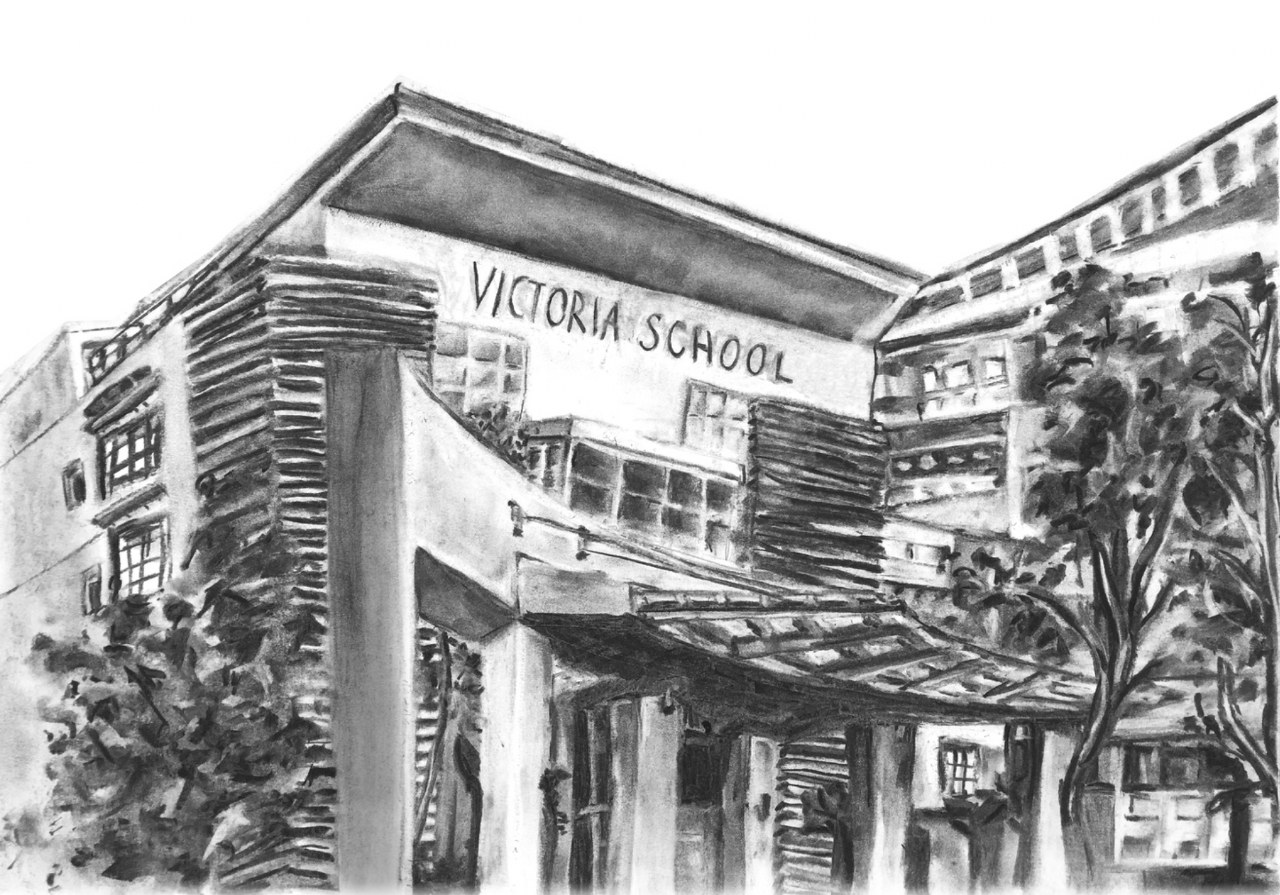 The Siglap Link campus was uniquely designed, guided by the school’s rich history, tradition and learning philosophy, which focused on the school mission to develop students into well balanced and all-rounded individuals.
The Siglap Link campus was uniquely designed, guided by the school’s rich history, tradition and learning philosophy, which focused on the school mission to develop students into well balanced and all-rounded individuals.
To symbolise the love for lifelong learning in our school crest, the roofs are shaped like open books. The school’s motto “Nil Sine Labore” was crafted into an overhanging feature on top of the parade square. When the sun is overhead, the words “Nil Sine Labore” can be seen clearly on the Parade Square and reminds Victorians of the school motto.
To emphasise the importance of learning, the library is at the school’s centre. In 2003, the 300-seater library was Singapore’s biggest government secondary school library. The Eco-street, which is the central green lung of the school, was designed to become an active learning space for life science projects, where students could engage in experiments and investigation. The ecological garden also helps to balance the concrete structures and built-up design of the campus. The plants, trees and water features provides an oasis of calm within the school compound where Victorians could relax, surrounded by the classroom and science laboratory blocks.
In order to maximise the use of space, the 11-storey 500-bedder hostel was conceived as a shared zone with the school to create synergy through the sharing of facilities. The hostel houses additional communal facilities such as a music room and activity room. The auditorium, located within the school, was conceived as a shared resource to be used by the school and hostel. To maximize the use of space, the school has seven storeys and the Parade Square is situated on the fifth storey, above the school Hall. As sport is important, space was made available for a full-size school field.[33] The field was replaced with an Astro Turf field in 2007 and an indoor sports hall was added in 2009.
[33] “Speech by Dr. Ong Chit Chung, Chairman, Victoria Executive & Advisory Committees at Victoria School’s 127th Speech Day, 26 July 2003,” The Victorian, 2003, 72.
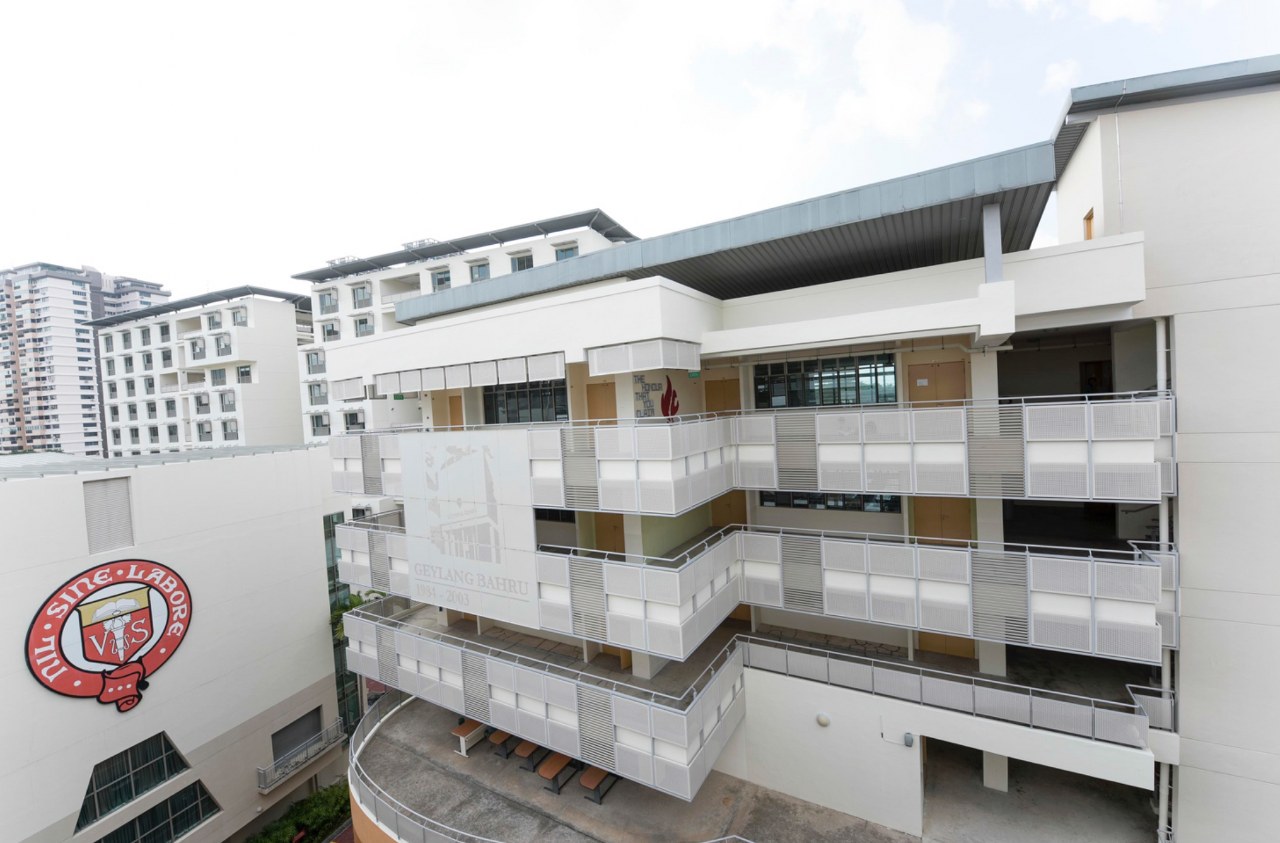 During this period, there were significant developments to the school programmes and curricular offerings. In 2007, Victoria School pioneered having Physical Education as an ‘O’ Level subject with the first cohort sitting for the National Examination in 2009. The course involves both theoretical and practical aspects, including modules on weight training, football, hockey, and cross-country running, among others. In 2008, the Ministry of Education introduced the Regional Studies Programme through four schools, Anglo-Chinese School (Independent), Raffles Institution, Raffles Girls’ School and Victoria School. Victoria School is the only school which offers Bahasa Indonesia among the 4 schools. A resident Bahasa Indonesia teacher was deployed to the school so that students need not travel to the Language Centre for their lessons. Regional Studies Programme students have the privilege of learning the language in school and go through a specially designed Understanding Southeast Asia module which is a study of people, places and cultures of Southeast Asia.
During this period, there were significant developments to the school programmes and curricular offerings. In 2007, Victoria School pioneered having Physical Education as an ‘O’ Level subject with the first cohort sitting for the National Examination in 2009. The course involves both theoretical and practical aspects, including modules on weight training, football, hockey, and cross-country running, among others. In 2008, the Ministry of Education introduced the Regional Studies Programme through four schools, Anglo-Chinese School (Independent), Raffles Institution, Raffles Girls’ School and Victoria School. Victoria School is the only school which offers Bahasa Indonesia among the 4 schools. A resident Bahasa Indonesia teacher was deployed to the school so that students need not travel to the Language Centre for their lessons. Regional Studies Programme students have the privilege of learning the language in school and go through a specially designed Understanding Southeast Asia module which is a study of people, places and cultures of Southeast Asia.
While these improvements were made, the educational landscape became more complex. At the fifth Principals’ Appointment Ceremony held in December 2002, then Minister for Education Teo Chee Hean announced the introduction of the Integrated Programme. The Integrated Programme was a key outcome of the upper-secondary and junior-college education review initiated in April 2002. It takes the form of a six-year programme and provides a seamless upper-secondary and junior-college education in which secondary-school students can proceed directly to junior college without taking the GCE ‘O’ Level Examination. It culminates in the GCE ‘A’ Level Certificate or other diplomas such as the International Baccalaureate. Schools offering the Integrated Programme will optimise the time freed up from preparing for the GCE ‘O’ Level to stretch students and provide greater breadth in the academic and non-academic curriculum. However, these schools will continue to have school-based assessments to measure students’ progress.
The first schools approved to implement the Integrated Programme from 2004 were the Hwa Chong and Raffles families of schools, National Junior College and Anglo-Chinese School (Independent). In 2005, Victoria Junior College began to offer the Victoria Integrated Programme. The Victoria Integrated Programme was a four-year Integrated Programme taking Secondary Three students from various secondary schools. As part of the partnership, the principals of Victoria Junior College and Victoria School worked together to channel more capable Victorians to join the Victoria Integrated Progamme.[34]
After 2005, to cope with the changing educational landscape and to ensure that Victoria School remains a school of choice for high-ability learners, much thought was put in for a strategic response to ensure Victoria School remains a premier boys’ school and to provide for a good intake of IP and O Level students for Victoria Junior College. Cedar Girls’ Secondary School was identified as a possible partner for a six-year Integrated Programme, together with Victoria School and Victoria Junior College. The origins of the partnership stemmed from common strengths. Both Victoria School and Cedar Girls’ Secondary School were autonomous schools, strong in sports, emphasised character and leadership development, and had students of comparable academic calibre. Victoria School and Cedar Girls’ Secondary School were also unofficially considered as brother-sister schools.
In 2009, Cedar Girls’ Secondary School agreed to the formation of the Victoria-Cedar Alliance, with the three schools offering the Victoria-Cedar Alliance Integrated Programme. Students would spend four years of secondary school in Victoria School and Cedar Girls’ Secondary School for boys and girls respectively, and the junior college years in Victoria Junior College. Under the proposal, Victoria School and Cedar Girls’ Secondary School would continue to offer the O Level Programme to half of their cohort, becoming dual-track schools offering both the Integrated Programme and the O Level Programme. A proposal was submitted to the Ministry of Education in 2009, and the Ministry approved the proposal in 2010. Further to the Ministry’s approval, the three schools worked closely together to develop the Victoria-Cedar Alliance Integrated Programme curriculum, teaching-learning resources and staff training programmes,
In 2012, Victoria School implemented the Victoria-Cedar Alliance Integrated Programme, together with Cedar Girls’ Secondary School and Victoria Junior College. The first batches of Victoria-Cedar Alliance Integrated Programme students were enrolled in Year 1 as their O Level peers were enrolled in Sec 1 at both Victoria School and Cedar Girls’ Secondary School.[35] Since the inauguration of the Victoria-Cedar Alliance in 2012, the partnership has grown and matured. Together, the three Victoria-Cedar Alliance schools (Victoria School, Cedar Girls’ Secondary School and Victoria Junior College) are successfully running the 6-year Victoria-Cedar Alliance Integrated Programme, which aims to develop the Social Innovator and Passionate Learner. The Victoria-Cedar Alliance partnership has further broadened to include the key areas of Co-Curricular Activities collaboration, talent development, student leadership development and sharing of good teaching-learning practices. The strong alliance has deepened student and staff learning across the three Victoria-Cedar Alliance schools.
[34] “The Victoria-Cedar Alliance,” Old Victorian’s Association, accessed June 10, 2016, http://www.ova.org.sg/2014/09/victoria-cedar-alliance/
[35] “The Victoria-Cedar Alliance,” Old Victorian’s Association, accessed June 10, 2016, http://www.ova.org.sg/2014/09/victoria-cedar-alliance/

